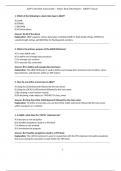Tentamen (uitwerkingen)
C_ABAPD_2309 - SAP Certified Associate – Back-End Developer - ABAP Cloud
- Vak
- Instelling
This course is designed to prepare participants for the SAP Certified Associate - Back-End Developer - ABAP Cloud (C_ABAPD_2309) certification. Learners will explore the fundamental concepts of ABAP programming in the cloud environment, focusing on the development of applications using the SAP Clou...
[Meer zien]




